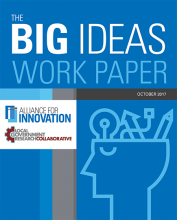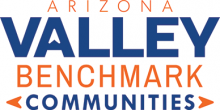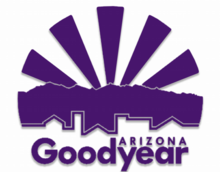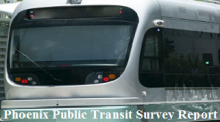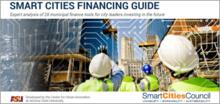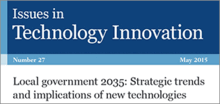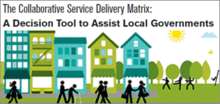
Center Highlights
Recent center highlights
Recent center highlights
Veteran Hiring Preferences in Local Government
Many Americans engage in public service through military service. The nation invests significant resources in training these individuals in a wide array of skills. Many of these skills translate very well to the kinds of talent local governments desire. Unfortunately, much of that talent fails to get positioned well for local governments except in the public safety field. But the talents our veterans have meet many local government needs. The Center for Urban Innovation and the Center for Organization Research and Design at Arizona State University worked with the Alliance for Innovation to conduct a survey of local government human resource directors of the Alliance’s members jurisdictions. The results of this initial effort appear in the 2019 report. Those results led our team to broaden the partnership to include the National League of Cities and MissionSquare to conduct a representative random survey of almost 600 local government human resource directors from around the US. The results of this much more extensive effort appear in the 2020 report and highlight several unexpected results that suggest many opportunities for local governments to tap the talent present in the veteran population in jobs across the jurisdictions’ service needs well beyond only public safety.
Veteran Hiring Preferences in Local Government – 2020 Report
Veteran Hiring Preferences in Local Government—2019 Initial Report
Navigating the Waters between Local Autonomy and State Preemption
Local government continues to be the source of new and innovative solutions to specific problems confronting the lives of residents. However, local officials across the country have expressed strong concerns about the recent growth in state restrictions and preemptions of municipal and county authority. State restrictions are increasing in the wake of other actions since the Great Recession that have frustrated local leaders efforts to serve and improve their communities. These include cutbacks in discretionary financial aid, off-loading functional responsibilities without commensurate revenues, and unfunded mandates. Due to political stalemate in Washington, D.C., combined with inaction in many state legislatures, a resurgence of fend-for-yourself federalism may be on the horizon. However, many local governments are forging ahead with innovations and experiments in a wide range of policy areas. Some legislators and governors want to rein in local governments, not empower them. As a result, state-local relations have become more contentious and adversarial. This paper examines these trends and provides a framework for helping local government officials understand how best to navigate these governance issues while states continue to wrestle with the questions of how best to meet the needs of their citizens.
Valley Benchmark Communities
Valley Benchmark Communities (VBC) is a group of 13 Arizona municipalities working to improve local government performance. As one of the largest and oldest performance management consortiums in the U.S. and covering a population of over 4 million in the Phoenix metro area, VBC creates a trend report that informs, represents, and supports its members and the general public on an annual basis. VBC, by working collaboratively with designated representatives from local governments and their communities:
- Identifies common demographic, financial, and performance information.
- Uses this information to better understand the similarities, differences, and complexities of community operations.
- Openly shares best practices, data, and other resources.
The 13 participating communities (in alphabetical order) are Avondale, Buckeye, Chandler, Gilbert, Glendale, Goodyear, Mesa, Peoria, Phoenix, Queen Creek, Scottsdale, Surprise, and Tempe.
Partnerships with Arizona State University (ASU), the Maricopa Association of Governments (MAG), and the International City/County Management Association (ICMA) have deepened the work of VBC and its member communities.
Valley Benchmark Communities Latest Trend Report: FY 2023-2024 Trend Report
Past Trend Reports
Goodyear Parks & Recreation Cost Recovery Report 2016
Executive Summary The Goodyear Cost Recovery Research Project reviews Goodyear’s Parks and Recreation fee structure and current cost recovery model in relation to program fees, rentals, and procedures against comparable cities in order to identify new and better options. The following report details data from comparable cities regarding fee philosophies, fees assessed, as well as rental policies and procedures. The Goodyear Cost Recovery Research Team collected data over an eight-week (from October 2015 to December 2015) from cities deemed comparable by Goodyear’s Parks and Recreation staff. The team collected research through e-mail requests, phone conversations, and city websites. While collecting data, the research team identified challenges related to finalizing the research. These challenges included missing information from cities that did not participate in the study, and missing common definitions of what costs are to be included when discussing and reporting cost recovery.
Public Opinion - Phoenix Public Transportation Survey Report
Public Transit Survey Report
The Center for Urban Innovation serves as Arizona State University’s focal point for research on urban affairs and is part of the College of Public Programs. Its mission is to improve the quality of life in neighborhoods, cities and urban regions by promoting innovation in governance, policy, and management. The Center undertakes basic and applied research published in books, journal articles, research reports, and public testimony. We provide training and development activities for local government officials. While the Center has a special interest in Arizona and the Phoenix region, its research and outreach has global impact through innovative education and training, critical research and community involvement in cities around the world.
Smart Cities Financing Guide
Smart Cities Council Financing Guide
"Cities everywhere are challenged by congestion, pollution, crime, aging infrastructure, falling budgets and many other issues. They need new strategies and new technologies to address those challenges. Smart technology is a key piece of the solution. But smart city projects come with price tags. And many smart technologies are relatively new and haven’t established the kind of track record financiers want to see, which makes securing capital investments even more challenging. Happily, there are numerous financing tools available to help cities and regional governments pay for smart city projects. This guide highlights 28 of the most promising — including alternatives to the traditional funding mechanisms municipalities have used for decades. It also includes: • Detailed analyses of each option based on 10 characteristics to help decision makers easily identify the best tools for specific types of projects. • Examples of how these tools are being used today.. The Smart Cities Council is grateful to the Arizona State University Center for Urban Innovation for the financial expertise and insights that made this Smart Cities Finance Guide possible. Please refer to page 76 to learn about the authors and the Center."
Jesse Berst, Chairman, Smart Cities Council
Issues in Technology Innovation
Brookings Research Website
Technological change is increasingly disruptive and destabilizing. In order to maintain effective governance systems, public sector entities must overcome stagnant tendencies and take a proactive stance—acting in the face of impending technological innovations. Future government entities must evolve into lean, responsive, and adaptive organizations capable of rapid response to societal shifts.
In this paper, authors Kevin C. Desouza, David Swindell, Kendra L. Smith, Alison Sutherland, Kena Fedorschak, and Carolina Coronel illustrate how technological advancements, such as the proliferation of drone technologies, artificial intelligence, autonomous vehicles, and peer-2-peer services, will introduce data privatization challenges and destabilize existing governance systems. In order to maintain effective service delivery, public sector entities must increasingly consider the ramifications technology will have on income inequality, fragile and conflict states, and immigration—just to name a few.
They conclude by urging policymakers and government managers to chart out trends based on data, model the interactions within complex systems, and study the pathways towards outcomes to unearth intended and unintended consequences of strategic choices. The authors argue that designing a path forward for local governments will require deliberate collaboration among diverse stakeholders, an immersive engagement with the data and scenarios that will shape local communities, and employment of decision-tools to model and simulate alternatives.
Collaborative Services Matrix
Collaborative Services White Paper
Collaborative Services Bibliography
Collaborative Services Decision Matrix Tool
The Enhanced Partnership represents the joint research efforts of the Alliance for Innovation, the International City/County Management Association, and the Center for Urban Innovation at Arizona State University. The Collaborative Services Decision Matrix Tool is the second product from this new partnership. Each product is designed to be a useful aid for local government officials tackling challenging opportunities. This report supports The Collaborative Service Delivery Matrix: A Decision Tool to Assist Local Governments. It highlights the results of research, case studies, extensive bibliographic reviews, and interviews used by the Enhanced Partnership in the development of the decision matrix. The Enhanced Partnership chose to invest in this project in order to develop a practical and low-cost decision instrument that local governments can easily employ and implement very quickly with existing staff. The tool helps communities determine whether or not entering into a collaborative service delivery arrangement is likely to result in achieving the jurisdiction’s goals.

